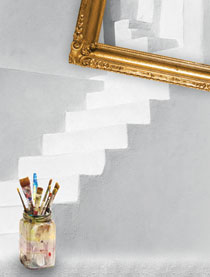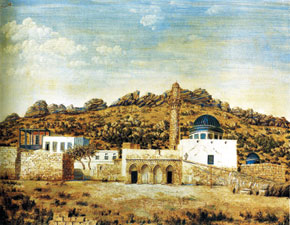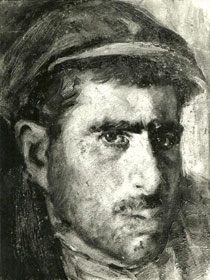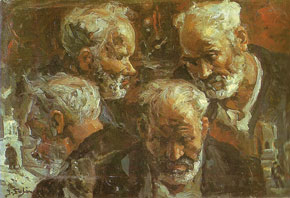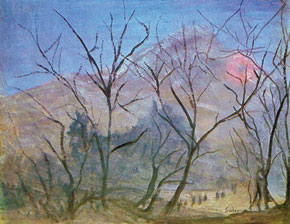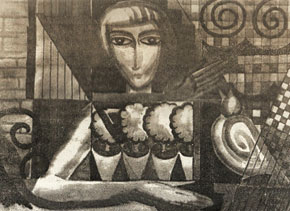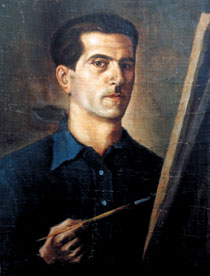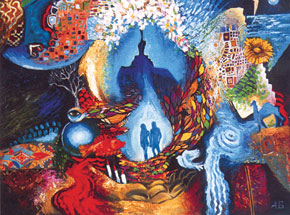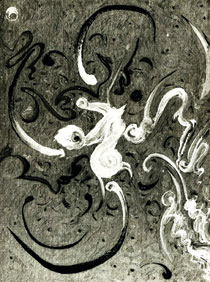Fate has scattered Azerbaijanis to the four corners of the world. This diverse diaspora includes many artists, some of whom longed to make a visit home during the communist era but found themselves in exile. It was not until the collapse of the Soviet Union and the restoration of Azerbaijan’s independence that contacts could be fully restored.
Indeed, many people in Azerbaijan had known nothing of the artists living abroad. They had their first glimpse of their work when an exhibition of émigré art was held in 1989 in the National Museum of Art in Baku.
Most of the artists visited their home country after long years of exile, making gifts of their work to public organisations, museums and individuals. Artists who could not afford the journey themselves sent their work to Baku through friends. As a result, there are now hundreds of works of art in museums and private collections in the republic produced by émigré artists.
ALI BEY HUSEYNZADE
One of the most interesting and influential artists to have lived and worked in exile is Ali bey Huseynzade (1864-1940). Alongside his work, he also wrote about art, most notably in an article “Green Lights in the Red Darkness” published in 1906 in Fuyuzat magazine. His interest in painting was sparked when he lived in Tiflis (Tbilisi) in the care of his grandfather, Ahmed Salyani, the Sheikh ul-Islam, or Muslim religious leader, of the Caucasus. He probably acquired his first knowledge of painting while a pupil at the Tiflis Gymnasium. He was to have studied at the St Petersburg Academy of Arts, but at the last moment changed his mind, opting for St Petersburg University instead.
Ali bey Huseynzade’s surviving works are portraits and landscapes. Some of his paintings remain with the family and were passed down via his son, Mammedsalim, who died in Paris a few years ago. Other works are owned by the artist’s daughter, Feyzaver, in Istanbul. Just three of Ali bey Huseynzade’s works are in Azerbaijan. One is a portrait of Ali’s grandfather, Sheikh ul-Islam Ahmed Salyani, which is in the Azerbaijan National Museum of Arts. The portrait in oils was painted in 1900. It was clearly precious to Ali bey, as he never parted with it. He even took it with him when he travelled to India for the Committee of Union and Progress, a social organisation and later political party in the latter days of the Ottoman Empire.
Another of his paintings depicts the Bibiheybet Mosque in approximately 1905-07. It’s a valuable record, as the mosque was blown up in 1936 as part of the communist authorities’ anti-religion drive. The painting remains in Azerbaijan thanks to the foresight of oil millionaire and philanthropist Haji Zeynalabdin Taghiyev. According to the story, when he heard that the British consul in Baku wanted to buy the picture and send it to London, the Haji bought the painting instead, saying: A picture of our ancient mosque should remain in our city. The work now hangs in the National Museum of Art.
The third picture remaining in Azerbaijan is a portrait of an old woman and a young girl. Drawn in pencil in Salyan in 1910 just before the artist left Azerbaijan for good, the subjects of the portrait are Nisa, the 75 year-old cousin of Ahmad Salyani’s wife, Husniye, and Boyukkhanim, the 11 year-old daughter of Ali bey's brother, Ismayil bey. The drawing is in the family collection of the nephew of landscape artist Sattar Bahlulzade. When he lived in Turkey, Ali bey painted this picture in oils.
Two portraits in Ali bey’s daughter’s collection are worth a special mention – one of Ataturk (1915) and one of Sheikh Shamil (1916). Their quality shows that Ali bey Huseynzade can rightly be considered a pioneer of Azerbaijani painting in the 20th century.
IBRAHIM SAFI
Born in Nakhchivan, Ibrahim Safi (1898-1983) moved to Turkey in 1918 where he lived for the rest of his life. He became a prominent artist there with solo exhibitions in the largest Turkish cities and museums. His work was the subject of many films and even advertisements. Writing to his relatives in Baku, Ibrahim Safi said: Not every artist in Turkey has this kind of advertising. Apparently, my mother's blessing is with me at every step.
It was not only his mother’s blessing that followed him all his life. Those who knew him well said that Ibrahim Safi kept a picture of Ilan Dag (Snake Mountain), the symbol of Nakhchivan, above his bed. It is said that whenever he was asked about the picture, he could not help crying.
Ibrahim Safi’s work is prized by collectors. Eleven of his pictures are in Azerbaijan: two of them were presented to the National Museum of Art by the artist's family, while the other nine were brought to Baku with the help of the late Professor Abbas Zamanov and are held in the Nizami Ganjevi Museum of National Literature. In the landscapes and still lifes, the transitions between limpid, eye-catching, optimistic colours are reminiscent of the French Impressionists. The cityscapes, on the other hand, give preference to architectural features and seasonal markers. The realistic portraits of his relative Zarrukh, itinerant musician Hafiz and an unnamed woman show his grasp of psychology.
In all his work, Ibrahim Safi plays with bright colours, which somehow seem to reflect an artist’s longing and sense of separation.
MAMMAD SELIM TURAN
Ali bey Huseynzade’s only son, Mammad Selim Turan (1915-93), spent his early life in Turkey before moving to Paris. He studied at the Turkish Academy of Arts (1935-38), then worked as a teacher in different parts of the country (1939-47). Selim Turan won first prize for his work at an exhibition in Ankara in 1941. Later, he travelled in Europe, familiarising himself with trends in continental art. He spent more than half a century in a rich exploration of artistic styles, creating some fascinating works. Selim Turan is known in the art world for his drawings, murals and original sculptures. Much of his work is in museums around the world, while he has murals at the University of Bordeaux and the Sorbonne.
His work can be divided into several periods in terms of colour. His black and white period is particularly distinctive. The artist described the meeting of these two colours as akin to the conflict of joy and sadness, hope and despair. If you pay attention to colour in Selim Turan’s work, you can see that only at first glance are red, green, blue and yellow ordinary colours. The artist has injected darkness into them, loading them with sadness. The grey blue of darkened trees cuts an expressive silhouette, while the “orphan” image of piles of yellowing flowers creates a mournful air.
Portraiture has a special place in Selim Turan's work. His series Exiled, which features some 30 people of different backgrounds and ages, reveals his understanding of human psychology. The portrait of poet Mollah Panah Vaqif, painted from the artist’s imagination, is especially worthy of note. The artist was also deeply affected by performances by Azerbaijani artistes in Paris during the Soviet era. His largely white portrait of Zita Babazade, entitled Dancer, is his record of one such performance.
Today, works by Ali bey Huseynzade and his son Selim Turan are exhibited in the Azerbaijan Museum of Art in Baku, something they probably never imagined. Maybe this is an illustration of the truism that great art always has a happy end.
AKBAR KAZIM MUGAN
In April 1986, an exhibition in the Bank of Cotton Gallery in Istanbul introduced the work of Akbar Kazim Mugan to the Turkish public. When the viewers wanted to express their admiration to the artist, they found he had died two years earlier. His son Nuru Mugan had organised the exhibition to fulfil his father's greatest wish.
Born in the village of Norashen in Nakhchivan, Akbar Kazim (1890-1979) studied at the Yerevan Gymnasium, and then in the law faculties of the universities of Kiev and Moscow. However, from childhood, he had cherished a desire to be an artist. So he cut short his legal education and passed the examination to enter the Moscow School of Painting, Sculpture and Architecture. There he took courses from Suprematist artist Kazimir Malevich.
In 1916 Akbar Kazim Mugan was sent by the Russian government to work in the city of Ardahan in Kars district in Turkey (at the time it was part of the Russian Empire). He taught painting in the local college for a while, then worked in the office of Ardahan municipality. From 1966 to the end of his life, he worked mainly as a beekeeper. The artist and his son Nazim made a major contribution to beekeeping in Turkey, writing a manual about it.
Akbar Kazim Mugan created some 100 oil paintings. Most of them are in private collections, with around 30 of them owned by his son Nuru bey. The main subjects of his work are scenes from daily life and portraits of people of various professions. There is just one painting in his homeland – Portrait of a Man, which was presented by his son Nuru to the Azerbaijan National Museum of Art during a visit to Baku.
KUBRA ASADULLAYEVA
The only female painter of note to have lived in exile, Kubra Asadullayeva (1901-85) was a granddaughter of oil millionaires and philanthropists Shamsi Asadullayev and Musa Naghiyev. Her sister, Umm El-Banu Asadullayeva, became a well-known writer in France under the pen-name Banine.
Kubra showed an interest in painting in childhood, but did not take it up professionally until she emigrated to Paris with her family. In the French capital she had lessons from well-known artists and became a member of the Russian group of painters for a while. Then under the influence of André Lhote, she became a successful Cubist painter.
In one of her Cubist portraits, Kubra Asadullayeva shows her sister Banine standing by a window. As is typical of Cubism, the artist uses a range of details to depict the writer’s world. Unfortunately, nothing is known of Kubra Asadullayeva’s other work. It is probably in private collections in France, where she spent most of her adult life.
Kubra Asadullayeva is buried in Batignolles Cemetery in Paris, not far from well-known Russian singer Fyodor Shalyapin’s grave.
AZER RASULZADE
The painful events of the 1930s will never be forgotten in Azerbaijan. It was a time when many of our compatriots were exiled from their native land and dispersed around the world. They were mostly innocent of the charges against them, as was proved much later when they were rightly acquitted. Those affected included the family of the founder of the Azerbaijan Democratic Republic, Mammad Amin Rasulzade. This family was never reunited. Mammad Amin was destined to roam between Germany, Poland and Turkey, while his son Azer lived in Kazakhstan.
Azer Rasulzade (1920-93) graduated from Baku Art College before exile to Kazakhstan. He married in Kazakhstan and lived there for the rest of his life. He was an enthusiastic school art teacher and later worked as a painter at the Art Fund in Karaganda. Azer Rasulzade successfully exhibited his work in various genres across Kazakhstan, but it was not until 1994 that the Azerbaijani public were able to see the work of Azer and his son Rais in Baku.
Azer Rasulzade painted Realist landscapes and portraits. A sense of longing and homesickness can be felt in many of his works, such as Self-Portrait (1950), Physician Abdurrahman Huseynov (1951), The Road (1960) and Summer Motif (1962). The artist makes fine use of colour to convey aspects of his subjects’ character. His use of colour in landscapes is striking, too. He had a particular talent to portray observed reality in a lyrical fashion.
ASHRAF HEYBATOV
Artist Ashraf Heybatov, who was born in 1952, left Baku almost 30 years ago and probably never imagined that he would return home only as a visitor. He lived first in Russia and then moved to Germany. He is now chairman of the Baku cultural society in the city of Koblenz and a member of the city authorities’ commission for work with foreigners.
Ashraf Heybatov is well-known for his thought-provoking work which reflects the Azerbaijani spirit in terms of history, culture, customs and traditions. He has been awarded the title Honoured Artist of the Azerbaijan Republic in recognition of his contribution to the development of Azerbaijani art.
ARAZ MIRHADI
When the USSR collapsed, Araz Mirhadi (1955-2012) was in the USA and remained there for the rest of his life. He had received his professional education in St Petersburg and Baku. The artist interpreted his faith in his work, taking a creative approach to classical calligraphy He also produced monumental works.
MANY MORE
These are not the only Azerbaijani artists to live and work abroad. Since the end of the last century, younger Azerbaijani artists have established themselves in the former Soviet republics or further afield. Examples include Kamil Kamal in Belarus, Qudrat Qurbanov (Gudrat Gurbanov) and Asgar Mammadov in Russia, Vagif Rakhman in Kazakhstan and Aga Ousseinov and Eldar Shafiyev in the USA.
